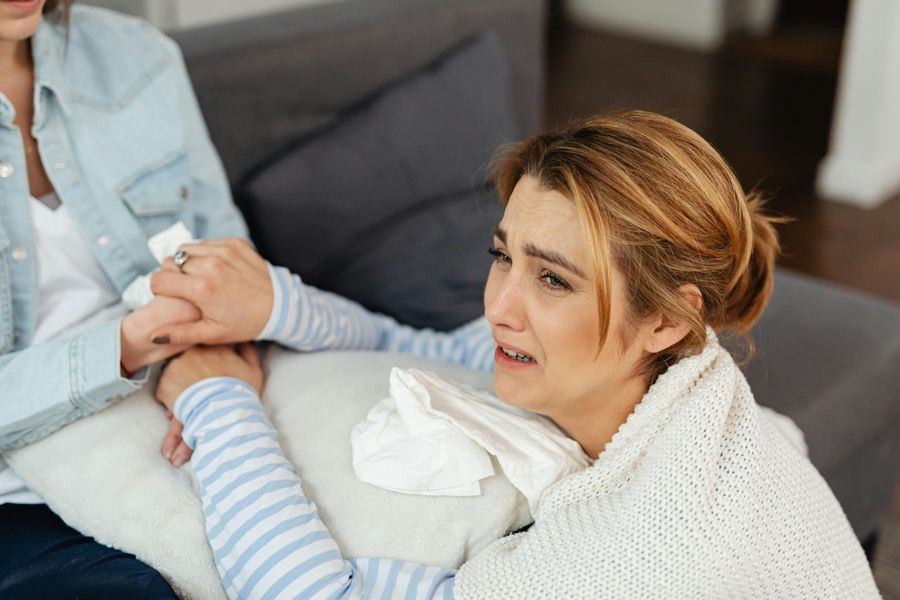Domestic Violence: Understanding and Addressing It
Domestic violence is one of the most pervasive and destructive social problems affecting our communities. It can involve physical, emotional, and psychological abuse, and it affects people of all ages, races, and socioeconomic backgrounds.
In this article, we will explore some of the myths surrounding domestic violence, the effects it can have on victims, and the real solutions that are available to those affected by it.
Myths about Domestic Violence
One of the most common myths surrounding domestic violence is that it only happens to women. While it is true that women are more likely to be victims, men can also be targets of domestic violence.
Similarly, while women are more likely to be perpetrators of emotional and psychological abuse, men can also be emotionally and psychologically abusive. Another myth is that domestic violence only happens in certain types of relationships, such as those with low socioeconomic status or those with a history of substance abuse.
In reality, domestic violence can happen in any type of relationship, regardless of income or social standing.
Emotional and Psychological Violence
While physical abuse may be the most visible form of domestic violence, emotional and psychological abuse can be just as devastating. Victims of emotional and psychological abuse may experience anxiety, depression, and a diminished sense of self-worth.
This type of abuse often involves tactics such as gaslighting, withholding affection, and controlling behavior, and it can be difficult to recognize and address.
Real Solutions
The good news is that there are real solutions available for those affected by domestic violence. One of the most important steps is to seek counseling, either individually or as a couple.
This can help victims to process their experiences and emotions, and it can provide them with the tools they need to move forward. Awareness and recognition are also key elements in combating domestic violence.
By acknowledging the problem and educating ourselves and others about its prevalence and impact, we can work to prevent it from happening in the first place. Victim support specialists and hotlines can also provide valuable resources and support to those affected.
Effects of Domestic Violence
The effects of domestic violence can be manifold and devastating. In addition to physical harm, domestic violence can undermine the trust and safety that are the foundation of any healthy relationship.
It can also lead to addiction-like behavior and the likelihood of repeated violence. Moreover, domestic violence is often linked to other negative outcomes such as substance abuse, work absenteeism, and even suicide.
This underscores the fact that domestic violence is not just an issue of physical harm, but one that has serious implications for the well-being of individuals and communities.
Conclusion
Domestic violence is a serious issue that affects people from all walks of life. By dismantling myths, addressing emotional and psychological abuse, and seeking real solutions, we can work towards a future free from violence.
If you or someone you know is affected by domestic violence, know that there is help available. Together, we can build a safer, healthier, and more compassionate world.
Salvaging a Relationship After Domestic Violence
Domestic violence is a complex and highly personal issue, and the decision to try to salvage a relationship after such violence has occurred is a delicate one. It requires a willingness to recommit, a recognition of the potential for denial, and a deep understanding of the circumstances and extent of the abuse.
Nature of the Abuse
The first step in attempting to salvage a relationship after domestic violence is to carefully consider the circumstances and nature of the abuse. Was the violence primarily physical in nature, or was there also emotional or psychological abuse involved?
Was the abuse a one-time occurrence, or has it happened repeatedly? What factors contributed to the abuse, such as substance abuse by one or both parties, or stress and difficult circumstances?
Context of Substance Abuse
The presence of substance abuse can make salvaging a relationship after domestic violence even more complex. Substance abuse can make it difficult to know whether a partner’s behavior was truly intentional, and it can also exacerbate other stressors and negative patterns of communication.
However, it is important to note that substance abuse does not excuse violent behavior, and both partners must be willing to address these issues honestly and with the help of professionals.
Mutual Forgiveness and Therapy
If both partners are committed to the healing process, mutual forgiveness and therapy can lead to successful reunions. This is not a quick fix or a pathway to healing, but rather a slow and often painful process of rebuilding trust and understanding.
In some cases, couples may find it helpful to attend individual and couples therapy together, in order to address the underlying issues that contributed to the violence and to build a stronger, more communicative partnership.
Examples Exist
While salvaging a relationship after domestic violence is not always possible or advisable, there are examples of couples who have successfully reunited after experiencing violence in their relationship. This is a highly individual process, and what works for one couple may not work for another.
However, if both partners are willing to commit to a process of healing and growth, there is hope for a brighter future.
Support for Domestic Violence Victims
Recognizing Signs
Recognizing the signs of domestic violence is the first step to offering support to victims. These signs can include physical indicators such as bruises or other injuries, as well as behavioral cues such as a partner becoming withdrawn or anxious.
It is important to remember that domestic violence does not always involve physical violence, and emotional and psychological abuse can be just as damaging.
Helping Friends and Loved Ones
If you suspect that a friend or loved one is a victim of domestic violence, it is important to approach the situation with care and sensitivity. Beginning the conversation with statements such as “I’m concerned about you” or “I’ve noticed some changes in your behavior” can help to open the door to communication.
It is essential to listen non-judgmentally, believe what the victim tells you, and validate their feelings and experiences.
Having an Escape Plan
For victims of domestic violence, leaving an abusive situation can be extremely complicated and fraught with risk. It is essential to offer support and resources for creating an escape plan that works for the victim’s individual circumstances.
This can include identifying safe places to stay, having a code word or signal to indicate danger, and developing a plan for contacting law enforcement or other support services if needed.
Fear of Reprisals
One of the most significant barriers to leaving an abusive situation is fear of reprisals from the abuser. It is essential to approach the situation with caution and to prioritize the safety of the victim above all else.
This may mean seeking help from law enforcement or other support services, providing a safe place to stay, and helping the victim to obtain a restraining order or other legal protections.
Conclusion
Salvaging a relationship after domestic violence is a complex and deeply personal process. It requires a willingness to recommit, a recognition of the potential for denial, and a deep understanding of the circumstances and nature of the abuse.
However, with commitment, healing, and professional support, it is possible to build a stronger and healthier relationship. For victims of domestic violence, recognizing the signs, offering support and resources, and prioritizing safety above all else are essential steps towards healing and recovery.
Moving Forward After Domestic Violence
Recovering from domestic violence can be a difficult and long process, but it is possible to move forward from the trauma and rebuild a healthy life. Here are some tips on how to move forward after domestic violence.
Acknowledging and Cherishing the Good Times
It’s essential to cherish the good times in life even after experiencing domestic violence. While it can be easy to be consumed by the negative aspects of the experience, it’s important to remember that there were likely good times in the relationship as well.
Acknowledging and cherishing these moments can help to create a sense of balance and hope for the future.
Self-awareness and Self-respect
After experiencing domestic violence, it’s important to gain a sense of self-awareness and self-respect. This means taking the time to understand your own needs, desires, and boundaries, as well as recognizing when these boundaries have been crossed.
By developing a strong sense of self-awareness and self-respect, it’s possible to build a healthier future and avoid being involved in another abusive relationship.
Never Again
One way to move forward after domestic violence is to make a declaration to yourself that you will never allow it to happen again. This declaration gives you power over your own life and draws a clear line that cannot be crossed.
It can be helpful to write this declaration down and keep it somewhere that you will see it often, reminding yourself of your commitment to never be involved in another abusive relationship.
Finding New Love and Partnerships
When moving forward after domestic violence, it’s important to be mindful of new love and partnerships. While it may be tempting to rush into a new relationship to distract from the pain of the past, it’s essential to take the time to heal and develop a sense of self-awareness and self-respect.
This heightened awareness can help to avoid being involved in another abusive relationship, and can lead to healthier and more fulfilling partnerships in the future.
Heightened Awareness and Self-Respect
As you move forward after domestic violence, it’s important to maintain a sense of heightened awareness and self-respect in all of your relationships. This means paying attention to potential signs of abuse, such as controlling behavior, and being assertive in protecting your own boundaries.
By valuing yourself and your own needs, you are less likely to be involved in another abusive relationship in the future. Recovering from domestic violence is a challenging process, but it is possible to move forward and build a healthier and more fulfilling life.
By cherishing the good times, developing a sense of self-awareness and self-respect, making a declaration to never be involved in another abusive relationship, and being mindful of new partnerships, it’s possible to create a brighter future. With the right support and resources, healing and growth are possible.
Conclusion
In summary, domestic violence is a complex and pervasive issue that affects individuals and communities all over the world. Understanding the myths and realities of domestic violence, recognizing signs of abuse, and offering support and resources to those affected are essential steps in creating a safer and healthier world.
Salvaging a relationship after domestic violence is a delicate and complex topic, but with a willingness to recommit, a recognition of the potential for denial, and a deep understanding of the circumstances and nature of the abuse, it is possible to move forward and build a healthier and more fulfilling life. By cherishing the good times, developing a sense of self-awareness and self-respect, making a declaration to never be involved in another abusive relationship, and being mindful of new partnerships, it’s possible to create a brighter future.
With the right support and resources, healing and growth are possible, and together, we can work towards ending domestic violence for good.



